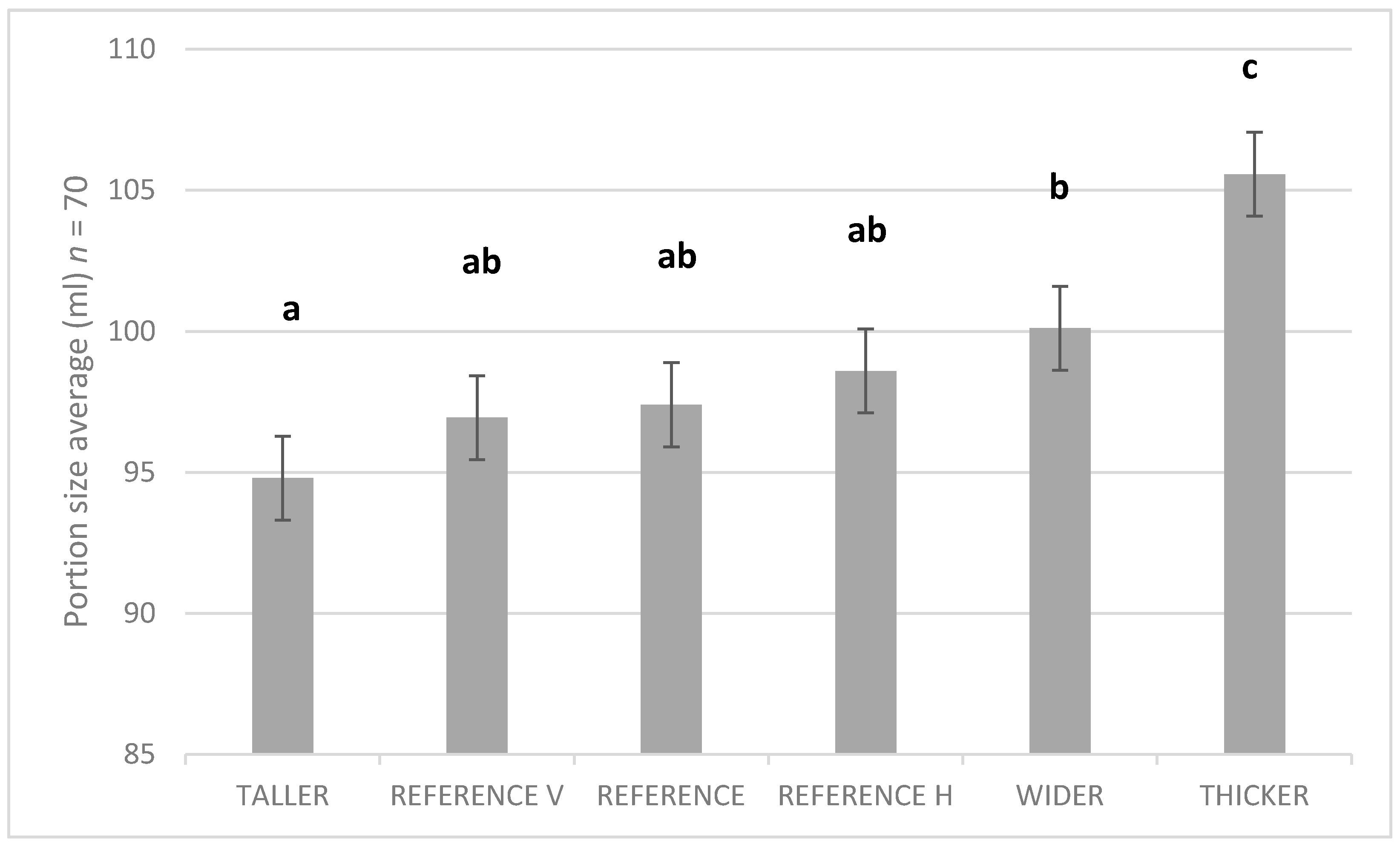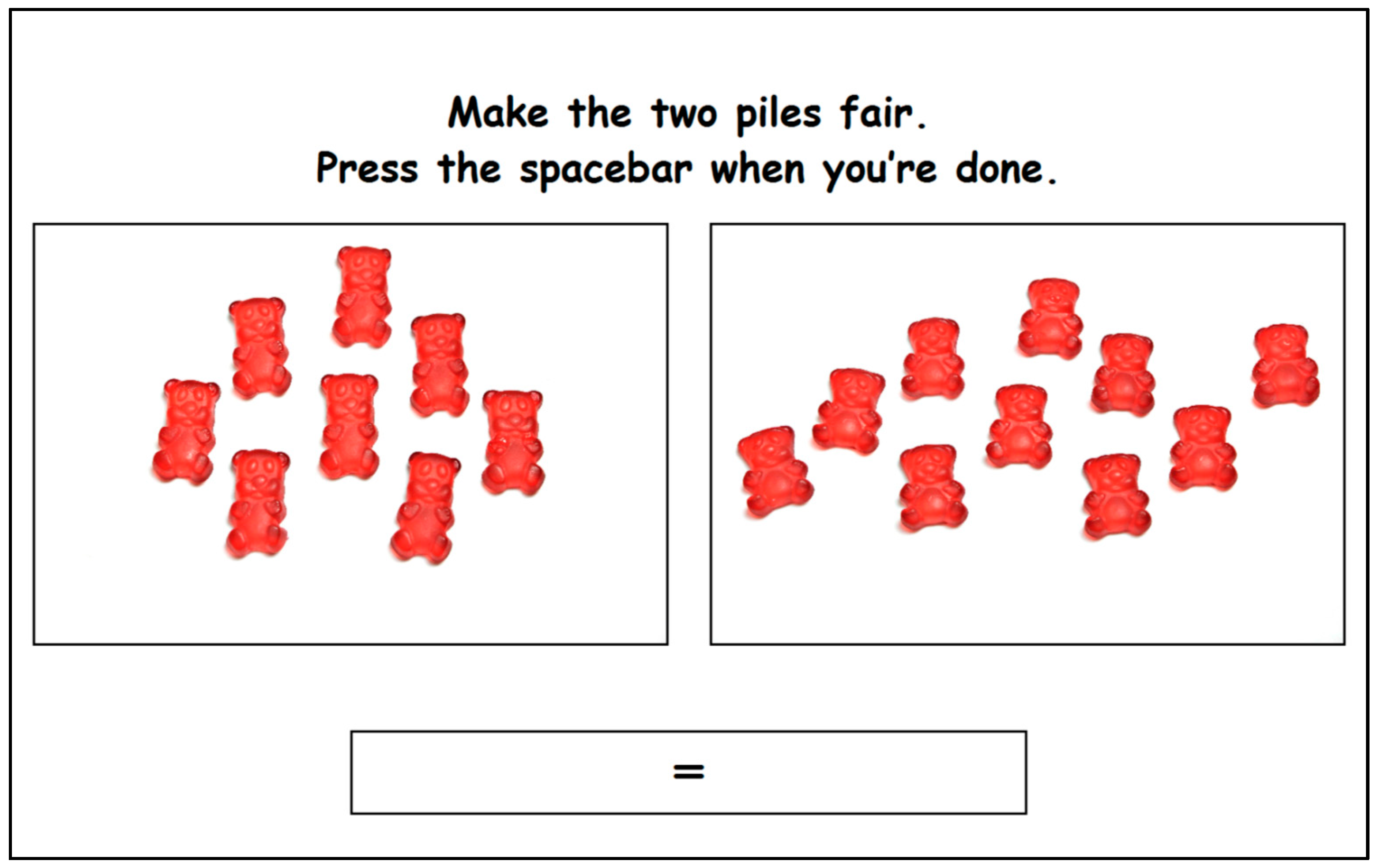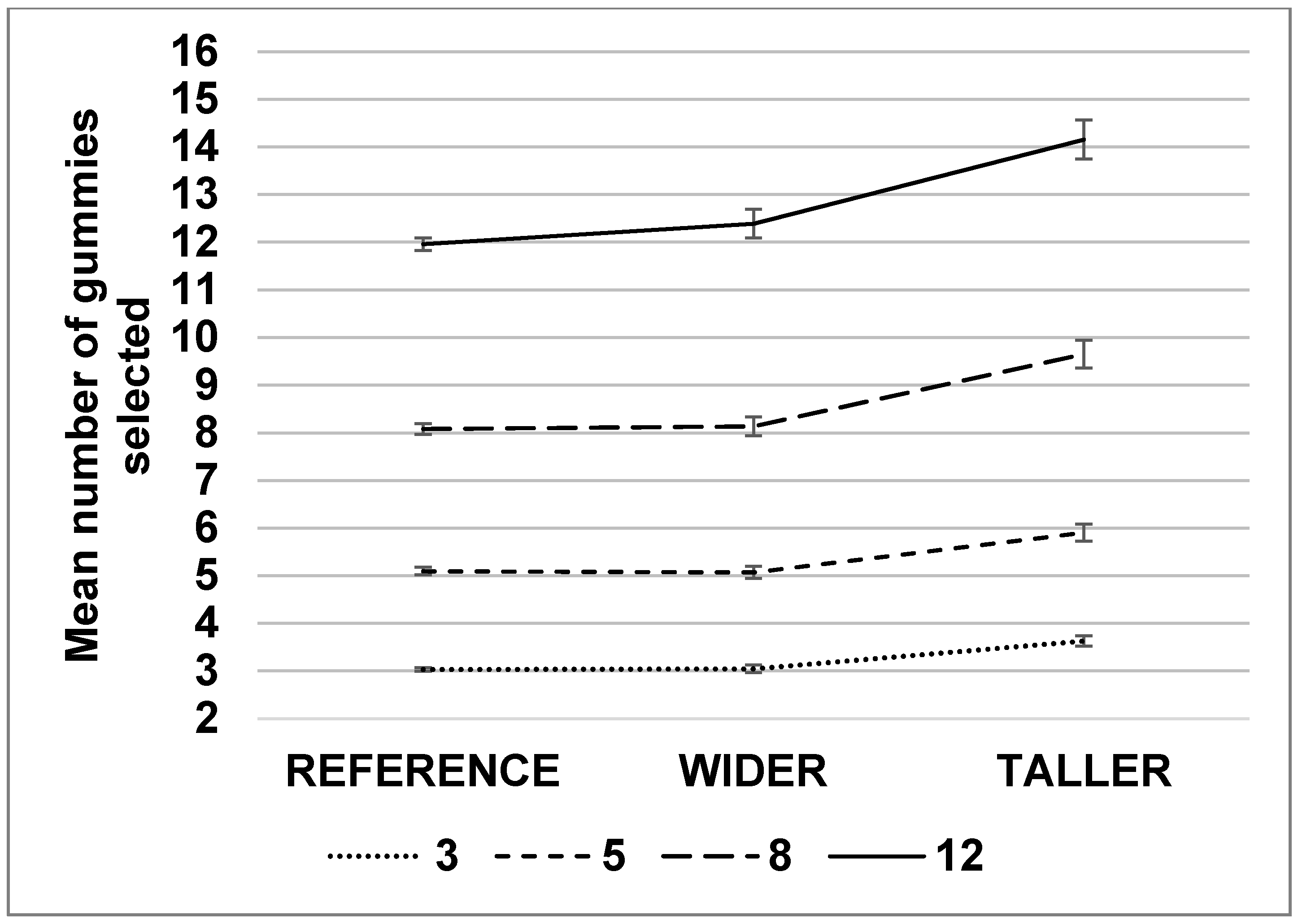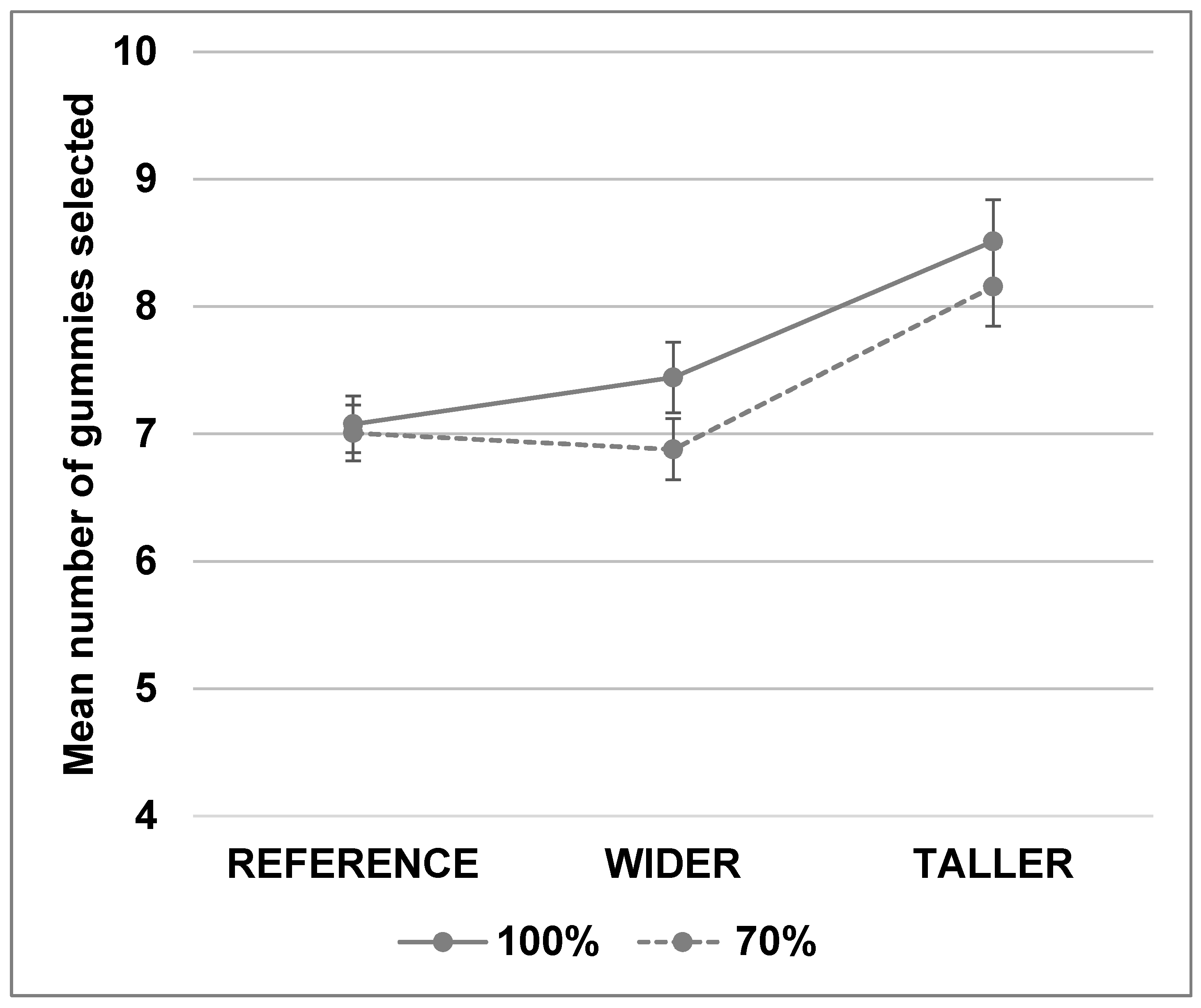Right Sizing: Sensory-Based Product Design Is a Promising Strategy to Nudge Consumers toward Healthier Portions
Abstract
:1. Introduction
1.1. Elongation and Size
1.2. Item Number and Size in Multi-Item Servings
1.3. Color Variety
1.4. Hypotheses Tested in the Current Study
2. Study 1
2.1. Methods
2.1.1. Participants
2.1.2. Ice Cream Pictures and Method of Adjustment Task
2.1.3. Statistical Analysis
2.2. Results
3. Study 2
3.1. Methods
3.1.1. Participants
3.1.2. Stimuli: Matching Task and Photographs
3.1.3. Matching Task
3.1.4. Statistical Analysis
3.2. Results
3.2.1. Impact of Size, Shape, and Number
3.2.2. Impact of Color Variety
4. Discussion
5. Limitations and Future Directions
6. Conclusions
Author Contributions
Funding
Acknowledgments
Conflicts of Interest
References
- Duffey, K.J.; Popkin, B.M. Energy density, portion size, and eating occasions: Contributions to increased energy intake in the United States, 1977–2006. PLoS Med. 2011, 8, e1001050. [Google Scholar] [CrossRef] [PubMed]
- Young, L.R.; Nestle, M. Reducing portion sizes to prevent obesity: A call to action. Am. J. Prev. Med. 2012, 43, 565–568. [Google Scholar] [CrossRef] [PubMed]
- Hollands, G.J.; Shemilt, I.; Marteau, T.M.; Jebb, S.A.; Lewis, H.B.; Wei, Y.; Higgins, J.P.T.; Ogilvie, D. Portion, package or tableware size for changing selection and consumption of food, alcohol and tobacco: A cochrane systematic review. Cochrane Database Syst. Rev. 2015, 9. [Google Scholar] [CrossRef]
- Benton, D. Portion size: What we know and what we need to know. Crit. Rev. Food. Sci. Nutr. 2015, 55, 988–1004. [Google Scholar] [CrossRef] [PubMed]
- English, L.; Lasschuijt, M.; Keller, K.L. Mechanisms of the portion size effect. What is known and where do we go from here? Appetite 2015, 88, 39–49. [Google Scholar] [CrossRef] [PubMed]
- Miller, P.H. Piaget’s cognitive-stage theory and the neo-piagetians. In Theories of Developmental Psychology, 4th ed.; Worth Publishers: New York, NY, USA, 2002. [Google Scholar]
- Crain, W. Piaget’s cognitive-developmental theory. In Theories of Development: Concepts and Applications, 5th ed.; Pearson Education: Upper Saddle River, NJ, USA, 2005. [Google Scholar]
- Raghubir, P.; Krishna, A. Vital dimensions in volume perception: Can the eye fool the stomach? J. Mark. Res. 1999, 36, 313–326. [Google Scholar] [CrossRef]
- Wansink, B.; Van Ittersum, K.V. Bottoms up! The influence of elongation on pouring and consumption volume. J. Consum. Res. 2003, 30, 455–463. [Google Scholar] [CrossRef]
- Krider, R.E.; Raghudir, P.; Krishna, A. Pizzas: Π or square? Psychological biases in area comparisons. Mark. Sci. 2001, 20, 405–425. [Google Scholar] [CrossRef]
- Wadhera, D.; Capaldi-Phillips, E.D. A review of visual cues associated with food on food acceptance and consumption. Eat. Behav. 2014, 15, 132–143. [Google Scholar] [CrossRef] [PubMed]
- Branen, L.; Fletcher, J.; Hilbert, L. Snack consumption and waste by preschool children served “cute” versus regular snacks. J. Nutr. Educ. Behav. 2002, 34, 279–282. [Google Scholar] [CrossRef]
- Boyer, L.E.; Laurentz, S.; McCabe, G.P.; Kranz, S. Shape of snack foods does not predict snack intake in a sample of preschoolers: A cross-over study. Int. J. Behav. Nutr. Phys. Act. 2012, 9, 94. [Google Scholar] [CrossRef] [PubMed]
- Van Kleef, E.; Vrijhof, M.; Polet, I.A.; Vingerhoeds, M.H.; de Wijk, R.A. Nudging children towards whole wheat bread: A field experiment on the influence of fun bread roll shape on breakfast consumption. BMC Public Health 2014, 14, 906. [Google Scholar] [CrossRef] [PubMed]
- Wada, Y.; Tsuzuki, D.; Kobayashi, N.; Hayakawa, F.; Kohyama, K. Visual illusion in mass estimation of cut food. Appetite 2007, 49, 183–190. [Google Scholar] [CrossRef] [PubMed]
- Kerameas, K.; Vartanian, L.R.; Herman, C.P.; Polivy, J. The effect of portion size and unit size on food intake: Unit bias or segmentation effect? Health Psychol. 2015, 34, 670–676. [Google Scholar] [CrossRef] [PubMed]
- Weijzen, P.L.G.; Liem, D.G.; Zandstra, E.H.; de Graaf, C. Sensory specific satiety and intake: The difference between nibble- and bar-size snacks. Appetite 2008, 50, 435–442. [Google Scholar] [CrossRef] [PubMed]
- Marchiori, D.; Waroquier, L.; Klein, O. Smaller food item sizes of snack foods influence reduced portions and caloric intake in young adults. J. Am. Diet. Assoc. 2011, 111, 727–731. [Google Scholar] [CrossRef] [PubMed]
- Geier, A.B.; Rozin, P.; Doros, G. Unit bias. A new heuristic that helps explain the effect of portion size on food intake. Psychol. Sci. 2006, 17, 521–525. [Google Scholar] [CrossRef] [PubMed]
- Davis, B.; Payne, C.R.; Bui, M. Making small food units seem regular: How larger table size reduces calories to be consumed. J. Assoc. Cons. Res. 2016, 1, 115–124. [Google Scholar] [CrossRef]
- Oldham-Cooper, R.E.; Wilkinson, L.L.; Hardman, C.A.; Rogers, P.J.; Brunstrom, J.M. Presenting a food in multiple smaller units increases expected satiety. Appetite 2017, 118, 106–112. [Google Scholar] [CrossRef] [PubMed]
- Van Kleef, E.; Kavvouris, C.; van Trijp, H.C. The unit size effect of indulgent food: How eating smaller sized items signals impulsivity and makes consumers eat less. Psychol. Health 2014, 29, 1081–1103. [Google Scholar] [CrossRef] [PubMed]
- Marchiori, D.; Waroquier, L.; Klein, O. “Split them!” Smaller item sizes of cookies lead to a decrease in energy intake in children. J. Nutr. Educ. Behav. 2012, 44, 251–255. [Google Scholar] [CrossRef] [PubMed]
- Rolls, B.J.; Rowe, E.A.; Rolls, E.T. How flavour and appearance affect human feeding. Proc. Nutr. Soc. 1982, 41, 109–117. [Google Scholar] [CrossRef] [PubMed] [Green Version]
- Rolls, B.J.; Rowe, E.A.; Rolls, E.T. How sensory properties of foods affect human feeding behavior. Physiol. Behav. 1982, 29, 409–417. [Google Scholar] [CrossRef]
- Rolls, B.J.; Rowe, E.A.; Rolls, E.T.; Kingston, B.; Megson, A.; Gunary, R. Variety in a meal enhances food intake in man. Physiol. Behav. 1981, 26, 215–221. [Google Scholar] [CrossRef] [Green Version]
- Kahn, B.E.; Wansink, B. The influence of assortment structure on perceived variety and consumption quantities. J. Consum. Res. 2004, 30, 519–533. [Google Scholar] [CrossRef]
- Brunstrom, J.M.; Shakeshaft, N.G. Measuring affective (liking) and non-affective (expected satiety) determinants of portion size and food reward. Appetite 2009, 52, 108–114. [Google Scholar] [CrossRef] [PubMed]
- Labbe, D.; Rytz, A.; Godinot, N.; Ferrage, A.; Martin, N. Is portion size selection associated with expected satiation, perceived healthfulness or expected tastiness? A case study on pizza using a photograph-based computer task. Appetite 2017, 108, 311–316. [Google Scholar] [CrossRef] [PubMed]
- Brunstrom, J.M.; Rogers, P.J. How many calories are on our plate? Expected fullness, not liking, determines meal-size selection. Obesity 2009, 17, 1884–1890. [Google Scholar] [CrossRef] [PubMed]
- Blake, P.R.; McAuliffe, K.; Warneken, F. The developmental origins of fairness: The knowledge-behavior gap. Trends Cogn. Sci. 2014, 18, 559–561. [Google Scholar] [CrossRef] [PubMed]
- Cohen, J. Statistical Power Analysis for the Behavioral Sciences, 2nd ed.; Laurence Erlbaum: Hillsdale, NJ, USA, 1988. [Google Scholar]
- Chandon, P.; Ordabayeva, N. Supersize in one dimension, downsize in three dimensions: Effects of spatial dimensionality on size perceptions and preferences. J. Mark. Res. 2009, 46, 739–753. [Google Scholar] [CrossRef]
- Redden, J.P.; Hoch, S.J. The presence of variety reduces perceived quantity. J Consum. Res. 2009, 36, 406–417. [Google Scholar] [CrossRef]
- Wilkinson, L.L.; Hinton, E.C.; Fay, S.H.; Ferriday, D.; Rogers, P.J.; Brunstrom, J.M. Computer-based assessments of expected satiety predict behavioural measures of portion-size selection and food intake. Appetite 2012, 59, 933–938. [Google Scholar] [CrossRef] [PubMed]
- Guillocheau, E.; Davidenko, O.; Marsset-Baglieri, A.; Darcel, N.; Gaudichon, C.; Tomé, D.; Fromentin, G. Expected satiation is correlated with amplitude of intake but does not fit well with actual consumption of desserts. Appetite 2018, 123, 183–190. [Google Scholar] [CrossRef] [PubMed]
- Wansink, B.; Johnson, K.A. The clean plate club: About 92% of self-served food is eaten. Int. J. Obes. 2015, 39, 371–374. [Google Scholar] [CrossRef] [PubMed]
- Rolls, B.J.; Roe, L.S.; Meengs, J.S. Reductions in portion size and energy density of foods are additive and lead to sustained decreases in energy intake. Am. J. Clin. Nutr. 2006, 83, 11–17. [Google Scholar] [CrossRef] [PubMed]
- Stroebele, N.; Ogden, L.G.; Hill, J.O. Do calorie-controlled portion sizes of snacks reduce energy intake? Appetite 2009, 52, 793–796. [Google Scholar] [CrossRef] [PubMed] [Green Version]
- French, S.A.; Mitchell, N.R.; Wolfson, J.; Harnack, L.J.; Jeffery, R.W.; Gerlach, A.F.; Blundell, J.E.; Pentel, P.R. Portion size effects on weight gain in a free living setting. Obesity 2014, 22, 1400–1405. [Google Scholar] [CrossRef] [PubMed] [Green Version]





| Shape | Height; Width; Thickness (mm) | Picture |
|---|---|---|
| REFERENCE | 94.0; 46.5; 24.5 |  |
| TALLER | 105.3; 41.0; 24.5 |  |
| THICKER | 89.0; 41.0; 29.5 |  |
| WIDER | 89.0; 55.0; 22.0 |  |
| REFERENCE V | 94; 46.5; 24.5 with vertical lines |  |
| REFERENCE H | 94; 46.5; 24.5 with horizontal lines |  |
| Shape | Size | Height; Width (mm) | Weight (g) | Picture |
|---|---|---|---|---|
| REFERENCE | Reference (100%) | 25; 19 | 3.5 |  |
| TALLER | Reference (100%) | 30; 16 | 3.5 |  |
| WIDER | Reference (100%) | 21; 23 | 3.5 |  |
| REFERENCE- | Reduced (70%) | 21; 16 | 2.5 |  |
| TALLER | Reduced (70%) | 25; 13 | 2.5 |  |
| WIDER | Reduced (70%) | 17; 19 | 2.5 |  |
© 2018 by the authors. Licensee MDPI, Basel, Switzerland. This article is an open access article distributed under the terms and conditions of the Creative Commons Attribution (CC BY) license (http://creativecommons.org/licenses/by/4.0/).
Share and Cite
Labbe, D.; R. Fries, L.; Ferrage, A.; Lenfant, F.; Godinot, N.; Martin, N. Right Sizing: Sensory-Based Product Design Is a Promising Strategy to Nudge Consumers toward Healthier Portions. Nutrients 2018, 10, 1544. https://doi.org/10.3390/nu10101544
Labbe D, R. Fries L, Ferrage A, Lenfant F, Godinot N, Martin N. Right Sizing: Sensory-Based Product Design Is a Promising Strategy to Nudge Consumers toward Healthier Portions. Nutrients. 2018; 10(10):1544. https://doi.org/10.3390/nu10101544
Chicago/Turabian StyleLabbe, David, Lisa R. Fries, Aurore Ferrage, Francine Lenfant, Nicolas Godinot, and Nathalie Martin. 2018. "Right Sizing: Sensory-Based Product Design Is a Promising Strategy to Nudge Consumers toward Healthier Portions" Nutrients 10, no. 10: 1544. https://doi.org/10.3390/nu10101544
APA StyleLabbe, D., R. Fries, L., Ferrage, A., Lenfant, F., Godinot, N., & Martin, N. (2018). Right Sizing: Sensory-Based Product Design Is a Promising Strategy to Nudge Consumers toward Healthier Portions. Nutrients, 10(10), 1544. https://doi.org/10.3390/nu10101544





